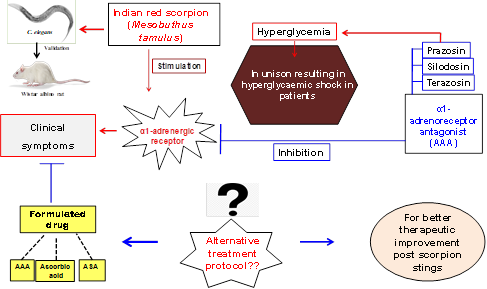Novel therapeutic formulation developed for improved treatment of Indian red scorpion sting
A new therapeutic drug formulation (TDF) comprising of low doses of commercial equine anti-scorpion antivenom (ASA), α1- adrenoreceptor agonist (AAAs) and vitamin C, for inhibiting the Indian red scorpion venom-induced toxicity and associated symptoms can help improve clinical management of scorpion sting patients.
Scorpion envenomation is a severe problem in many countries of the world. The Indian red scorpion (Mesobuthus tamulus), with its life-threatening sting, is one of the world’s most dangerous scorpions. Intravenous administration of equine anti-scorpion antivenom (ASA), raised against M. tamulus venom (MTV), is the only available treatment for scorpion stings. However, the low proportion of venom-specific antibodies against the most abundant low molecular mass channel toxin is a barrier to efficient clinical management of scorpion sting patients. Therefore, the high antivenom requirement may lead to adverse serum reactions in treated patients. Scorpion envenomation and its treatment needs extensively research and alternative therapies.
Conventionally, α1- adrenoreceptor agonist (AAAs), such as Prazosin, is also used alone or in combination with commercial ASA for the treatment of stung patients; however, this therapy is less effective and associated with certain limitations.
To solve this critical issue, a team of scientists from Institute of Advanced Study in Science and Technology (IASST), an autonomous institute of Department of Science and Technology as well as reserachers from scholars from Tezpur University NIELIT, Guwahati have invented novel therapeutic drug formulations (TDF) comprised of low doses of commercial ASA, AAA, and vitamin C, for inhibiting the Indian red scorpion venom-induced toxicity and associated symptoms.
The drug’s efficacy was first tested on Caenorhabditis elegans, a free-living nematode model, as an alternative to an in vivo animal model. The research was recently published in the journal Toxins. An Indian patent has also been filed on this novel drug formulation.
The study by the team comprising Prof. Ashis Mukherjee, Director, Dr. M. R. Khan, Associate Professor, and Dr. Aparup Patra, IPDF from IASST, Dr. Bhabana Das, and Upasana Pujari from Tezpur University, and Dr. S. Mahanta, from NIELIT, Guwahati demonstrated for the first time that C. elegans can be a good model organism for screening the neutralization potency of the drug molecules against a neurotoxic scorpion venom.
The novel TDF efficiently neutralized the Indian red scorpion venom, induced increase in blood glucose level, organ tissue damage, necrosis, and pulmonary edema in Wistar rats, much better than commercial ASA, AAA, and vitamin C. The treatment holds promise for effective treatment against scorpion stings and will save the lives of millions of patients worldwide.
Link to publication:
https://doi.org/10.3390/toxins15080504
For more details, please contact: Prof. Ashis Mukherjee, Director, IASST at [email protected] or Dr. M. R. Khan, Associate Professor, IASST at [email protected]


